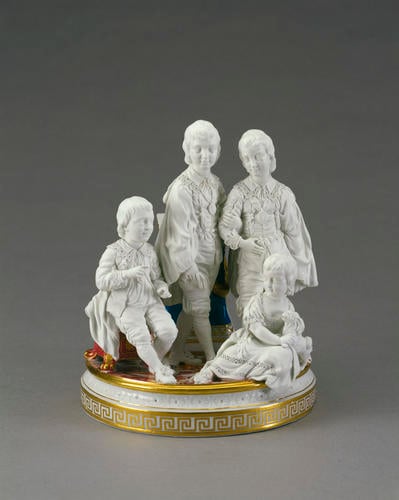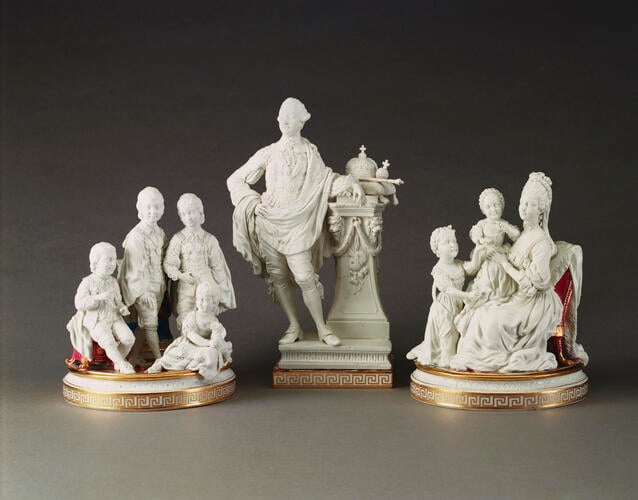-
1 of 253523 objects
The four eldest sons of George III; George IV when Prince of Wales, with Princes Frederick (later Duke of York), William (later Duke of Clarence and William IV) and Edward (later Duke of Kent) c.1773
Biscuit porcelain | 22.0 x 18.0 x 17.7 cm (whole object) | RCIN 37021

Derby Porcelain Works (c. 1750-1876) : Derby
The four eldest sons of George III; George IV when Prince of Wales, with Princes Frederick (later Duke of York), William (later Duke of Clarence and William IV) and Edward (later Duke of Kent) c.1773


-
A Chelsea-Derby biscuit porcelain group of the four eldest sons of George III, in van Dyck dress, Prince William seated on a polychrome pink and gilded stool, Princes George and Frederick standing, Prince Edward seated with with a dog, the whole on gilded plinth with circular marble base.
This delicate group of figures is extremely rare, not only in itself but as an example of the reproduction in porcelain of an elaborate painted composition. Zoffany’s group portrait of the royal family in ‘van Dyck’ costume was painted early in 1770, and this porcelain group was probably modelled from the engraving by Richard Earlom published in October of that year. The modeller, probably the sculptor John Bacon, adapted the arrangement of the figures so as to accommodate them within the base, and focused the attention of the group of four Princes more directly on the cockatoo held by Prince William, which is now missing.
The royal groups, of which this is one, are the first item in a list of ‘the Principal Additions made this Year to the new Invented Groups, Vases . . . of Mr Duesbury’s Derby and Chelsea Manufactory of Porcelaines’. This was probably issued shortly after June 1773, when William (II) Duesbury (1725-86), the proprietor of the Derby Porcelain Works, set up his new warehouse in London, having acquired the discontinued Chelsea manufactory in 1770. The groups of the royal family were clearly intended to promote the wares of the new company and, in particular, its biscuit figures modelled in a new body rich in bone ash and intended to rival the productions of Sèvres. Both George III and Queen Charlotte made numerous purchases of ‘useful’ wares from the London warehouse during the following decade.
Catalogue entry adapted from George III & Queen Charlotte: Patronage, Collecting and Court Taste, London, 2004Provenance
Possibly belonged to Princess Sophia (1777-1848), daughter of George III and Queen Charlotte; Lady Carrington; by descent to 3rd Lord Carrington, later Marquess of Lincolnshire; Albert Amor Ltd.; from whom purchased by Queen Mary, 1924.
-
Creator(s)
(porcelain manufacturer)(porcelain manufacturer)Acquirer(s)
Subject(s)
-
Medium and techniques
Biscuit porcelain
Measurements
22.0 x 18.0 x 17.7 cm (whole object)
Place of Production
Derby [Derbyshire]